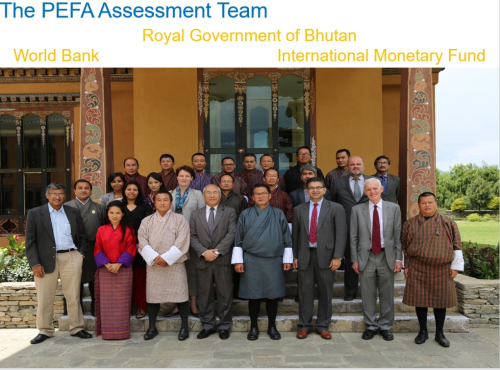
Posted by Sonam Tobgyel[1]
Bhutan has a very strong commitment to Good Governance which is one of the four pillars of the country’s Gross National Happiness (GNH) Index and one of the nine domains of the same index. Improving governance and accountability is one of the main priorities of the Royal Government of Bhutan (RGoB) and strengthening PFM is a key element of good governance. To improve PFM, the RGoB has used the Public Expenditure and Financial Accountability (PEFA) Assessment tool, which involves evidence-based measurements of a country’s PFM system to provide a scorecard of performance against various indicators and prepare a well-sequenced reform strategy. Bhutan had undertaken various reforms even before the first PEFA Assessment was carried out. However, it was only after the PEFA Assessments of 2010 and 2016 that the country was able to leap forward with a more structured and sequenced reform strategy which has already had a marked impact on the country’s fiscal performance.
The PEFA Assessment 2016 was a critical step forward. It was a guided self-assessment that was fully owned by the government and received technical support from the World Bank and the IMF. The chart below summarizes how the Assessment was organized. Important factors were commitment and support from the highest levels in the Government and acceptance of the need for international validation of the findings and ratings. To put this second principle into effect, the RGoB identified a designated official (focal person) to be responsible for each performance indicator and another official (nodal person) to coordinate the inputs of the various ministries and departments involved. Experts hired by the PEFA Secretariat supported the Assessment. The World Bank and IMF reviewed, validated and commented on the draft report.
This 2016 Assessment was used as a basis for the preparation of the comprehensive, sequenced and time-bound PFM Reform Strategy 2017-2021. This Strategy was supported by a PFM Multi-Donor Fund (PFM-MDF) that received contributions from the European Union (EU) and the Austrian Development Agency (ADA). The Fund was administered by the World Bank. Examples of key reforms implemented under this strategy include the introduction of a Goods and Services Tax (GST), an electronic Government Procurement (e-GP) system, an Integrated Financial Management Information System (IFMIS), an electronic payment system, the introduction of international accounting standards (IPSAS), strengthening the Accounting and Auditing Standards Board of Bhutan (AASBB), and the development of internal audit functions. The RGoB is committed to continue pursuing PFM reforms. These include the development of a modern Chart of Accounts, adoption of a Treasury Single Account (TSA), and discontinuing the existing Letter of Credit system. Over the years, the PFM system has undergone a sea change from manual procedures to the present web-based online system called the Electronic Public Expenditure Management System (e-PEMS). This system enables much tighter expenditure control and more timely and efficient financial reporting. The adoption of cash-basis IPSAS reporting will enhance the quality and transparency of public sector financial statements. There are also plans to carry out a new PEFA Assessment which would review progress since the 2016 evaluation and reassess the PFM Reform Strategy. [1] Department of Public Accounts, Ministry of Finance, Bhutan. Note: The posts on the IMF PFM Blog should not be reported as representing the views of the IMF. The views expressed are those of the authors and do not necessarily represent those of the IMF or IMF policy.
This exercise helped the Government to measure the progress made since the previous PEFA Assessment of





